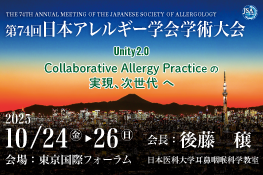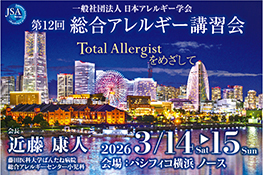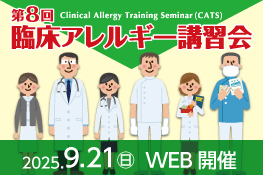History of JSA
1. History of the establishment of the Society
In 1949, the Allergy and Anaphylaxis Research Team was formed by the Ministry of Education, Science, Sports and Culture's Scientific Research (integrated research), and researchers from all over Japan who had been involved in research in this area gathered to promote integrated basic and clinical research for three years, led by Dr. Keizo Nakamura (National Institute of Health). In the process, momentum rose for the establishment of a society for the study of allergies. In 1951, the International Association of Allergy (currently officially known as the World Allergy Organization) was established and the first meeting was held in Zurich, which triggered rapid preparations for the establishment of the Japanese Society of Allergology, and in April 1952, a promoter committee was formed and the rules of the society were formulated. The number of members was about 600, and an office was established in the Department of Bacteriology, Nippon Medical School. The first general meeting was then held in Tokyo on October 17 and 18, 1952. There were hundreds of participants.
2. History after the establishment of the Society
- Since the first general meeting, an annual meeting was held every year until the 54th meeting in November 2004, following which the name was changed to the Fall Academic Conference in 2005 and further changed to the Academic Conference in 2015. In the meantime, the first Spring Clinical Conference was held in April 1989 and the conference continued to be held until 2014.
- The journal "Allergy" was published quarterly (four issues per year) in 1952 and 1953, the first fiscal year of the society and bimonthly (six issues per year) from 1954 to 1959, and it has been published monthly since 1960.
- The International Congress of Allergy and Clinical Immunology (now known as the World Allergy Congress) was held three times as the host country: November 1973 (Tokyo), October 1991 (Kyoto), and September 2020 (Kyoto).
- In October 1987, the “System for a Board-Certified Allergist" was established.
- The Society's office was moved to "Hakusan" in April 1988, then to "Hongo" in December 1989, and to "Ueno" in July 2009.
- “Allergology International,” an English-language journal, was published in March 1996.
- In September 1996, "Department of Allergy" was approved as the name of the department.
- In October 2005, the establishment of an incorporated association, the Japanese Society of Allergology, was approved, and in April 2012, it became a general incorporated association under the reform of public interest corporations.
- In June 2014, the Basic Law on Allergic Disease Control was promulgated, and subsequently in March 2017, the Minister of Health, Labour and Welfare issued the "Basic Guidelines for the Promotion of Allergic Disease Control." In response, the "Telephone Consultation Project for the Public on Allergy and Rheumatism" was established in April 2017 (until March 2019) under a project supported by the Ministry of Health, Labour and Welfare, the "Allergy and Rheumatism Consultant Training Workshop" was held from September 2017, the "Allergy Portal" was established in October 2018, and "Training Materials for Facility Personnel on Allergy" was published in March 2019.
- The first general allergy workshop was held in December 2014 and has been held annually since then.
- In June 2018, branch offices were established in eight locations across the country.
3. Present state of the Society
The Society is composed of basic medical scientists and clinicians who share a common research interest in allergy and clinical immunology. The main clinical specialties are bronchial asthma, hypersensitivity pneumonitis, allergic rhinitis, hay fever, urticaria, atopic dermatitis, food allergy, drug allergy, and immunodeficiency, all of which are based on allergic/immune reactions, but there are many other allergy-mediated diseases that are also addressed. The Society contributes to guiding medical practice in allergy by publishing guidelines such as “Japanese guidelines for the diagnosis and treatment of allergic diseases”, “Asthma prevention and management guidelines”,“Guidelines for the management of atopic dermatitis” and “Anaphylaxis guidelines” as well as “Official manual on allergen immunotherapy”. The Society also collaborates with patient groups.



